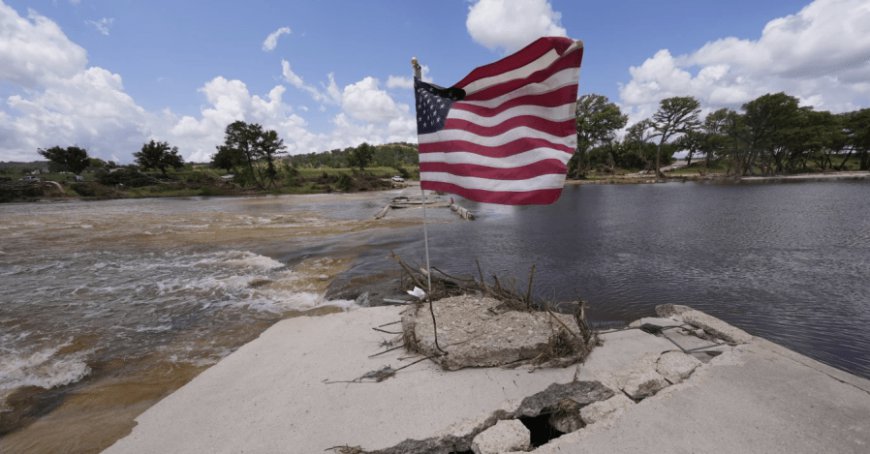Why do "once-in-a-lifetime" floods keep occurring?
Extreme flooding events have become more frequent and severe in 2025, with Texas, New Mexico, North Carolina, and New Jersey experiencing devastating floods. What are the reasons leading to these reoccuring events?

In the past two weeks, deadly flooding has taken up the majority of the news cycle as this events seem to keep reoccurring. 2025 is becoming the year of extreme flooding as we keep etching ourselves into the record books time and time again with precipatition.
The spring was no exception. Locally, April was the wettest month ever recorded as we picked up 13.29", only for May to bring 7.57". Together, those two months combined to be the wettest two-month stretch since 1958.
We have been locked into an active pattern. This year alone, the National Weather Service has issued 3,045 flood warnings, the most warnings ever recorded since data started being tracked in 1986.
Over the last couple of weeks, it seems flooding has drastically ramped up. In July alone, "once-in-a-lifetime" floods have occurred in Texas, New Mexico, and North Carolina. These events alone resulted in 139 fatalities. To put that number in perspective, 145 fatalities occurred during all of 2024.
Is this truly once-in-a-lifetime?
The terms that keep getting thrown around are "1000-year flood" and "once-in-a-lifetime flood." Now it's important to clarify what this actually means. A 1000-year flood doesn't mean a flood that happens once every thousand years. Rather, it means there's a 0.1% chance of a flood to scale happening any given year.
While the randomness of weather always plays a role, the cluster of these extremes is hard to chalk up to pure coincidence. July 2025 has already recorded more than double the usual number of major flooding events. What was once rare is starting to become more and more common.
Why do these events keep happening?
The frequency at which these storms occur is unsettling, to say the least. What's going on? Can we expect these storms to keep materializing?
Summer is the flash flooding season.
Historically, the most active season for flash flooding in the United States is right now. Summer. Warmer temperatures are able to hold more moisture than colder air masses. Combining this with tropical Gulf moisture, atmospheric instability, slow-moving storms due to weak upper-level forcing, and aggressive daytime heating, you have all the ingredients ripe for downpours.


The fact that we are seeing a drastic uptick in flash flooding during the summer simply makes sense. If there were any time in the year to see this occurring, it would be now.
Urbanization and Aging Infrastructure aren't helping
Modern-day cities are becoming concrete jungles. This means even moderate downpours can quickly turn dangerous. Pavement and buildings prevent water from soaking into the ground. The recent flooding in New Jersey and New York is a perfect example of how deadly this can be.
Stormwater is funneling into overwhelmed drains, unable to be properly redirected. New York City subway stations were trapped commuters and water levels quickly rose. Imagine how worse of an event this could have been if storms were even stronger.
City officials said their venerable sewer system worked as well as it could, but it simply was not built to handle that much rain.
“Imagine putting a two-liter bottle of water into a one-liter bottle. Some of it’s going to spill,” Environmental Protection Commissioner Rohit Aggarwala said at a virtual news briefing Tuesday.
A lot of city drainage systems are outdated and simply unable to handle rapid amounts of rainfall.
On the other side of the coin, Kerr County, Texas, has the opposite problem. Flooding impacted an extremely rural area, meaning the majority of residents had little to no warning before waters rose. Weather alert systems were either outdated or non-existent, leading to the disaster we saw.
A warmer atmosphere leads to more rain
It's time to address the elephant in the room. Is this due to climate change? I think it is important to discuss and break down all the factors that could lead to a drastic uptick in extreme flooding, which is why I saved this topic for last. But yes, a warming climate would lead to stronger flooding events.
Just like we addressed earlier, warmer temperatures mean the atmosphere can hold more water vapor. Air masses can hold roughly 4% more moisture for every one-degree increase in temperature.
Increasing Temperatures -> Increase in Precipitable Water -> Increased Flooding Risk
The important question to ask when forecasting extreme flooding events is not, "How much will it rain?" Rather, the critical question is, "How quickly will it rain?" Additional mositure trapped into thunderstorms are fueling aggressive and powerful downpours capable of dumping half a foot of rain in a matter of hours.
With active storms dominating much of the weather for the month of July, it will only be a matter of time before more occur. It is critical we take what we have learn over the recent storms to make the necessary changes to adapt.
What's Your Reaction?























